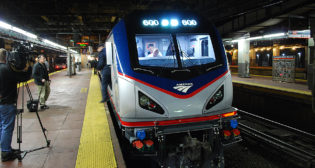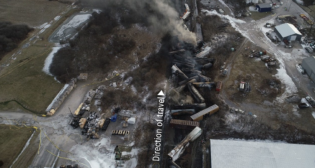
Canada cracking down on CBR shippers
Written by William C. Vantuono, Editor-in-ChiefShippers are attempting to sidestep the testing requirement by simply classifying all crude as the most volatile “Packing Group I” instead of specifically grading the crude according to flash point, corrosiveness, and chemical composition, according to investigations by Canada’s Globe and Mail.
Canadian Transport Minister Lisa Raitt also said existing hazmat classifications are inadequate for the highly volatile crude being extracted by fracking from the Bakken oil field that straddles North Dakota and Saskatchewan and also includes parts of Montana and Manitoba.
The presidents of Canadian Pacific and CN have publicly urged Transport Canada to tight the regulation of crude oil shipments. As common carriers, the railroads have no legal right to refuse any consignment that appears to meet regulations with respect to classification and container type.
In addition, railroads and crude oil shippers will be required to permanently deploy emergency response teams and equipment along Canada’s oil train routes. Such “Emergency Response Assistance Plans” were implemented for trains carrying propane and chlorine after a 1979 tank car explosion west of Toronto.
The new enforcement actions are meant to reduce the chances of another conflagration such as the July 6, 2013 explosion of a runaway Montreal, Maine & Atlantic train carrying highly volatile North Dakota crude in the Quebec resort community of Lac-Mégantic. It also follows harsh criticism by Canada’s auditor-general accusing Transport Canada of stubborn laxity in regulating the country’s sprawling railroad system.
In demanding an action plan, Transport Minister Raitt let slip an unprecedented rebuke of her own department:
“Unfortunately, in the history of Transport Canada, we have seen conversations and consultations that seem to go on for 10 years, and 15 years,” Raitt said. “So we gave them the end of January as the deadline.”
Raitt said she wants a fundamentally fresh regulatory regime for CBR in place by mid-2014.
Such tough talk is uncharacteristic of Canada’s Conservative government, whose power base is the energy-rich province of Alberta. It would also be unusual for the Canadian government to initiate domestic rail regulation ahead of U.S. authorities. This may suggest that similarly tough rules will be forthcoming from Washington.
The U.S. Federal Railroad Administration advised petroleum shippers July 29 that they must explicitly test each and every tank car contents before classification:
“Tank cars containing crude oil are typically loaded by one of two methods: transloading (where crude oil from cargo tanks is transferred directly into tank cars) or bulk loading operations (where crude oil is delivered to a bulk storage facility and the crude oil is then transferred from storage tanks to the railroad tank cars). In both operations, there is a blend of crude oil from a variety of sources in each tank car and the properties of the materials may vary depending on the constituent crude oils.
“Only after the properties of a hazardous material are determined and the material is properly classified can a shipper ensure compliance with the HMR (Hazardous Material Regulations). In the case of crude oil, relevant properties to properly classify the material include: flash point, corrosiveness, specific gravity at loading and reference temperatures, and the presence and concentration of specific compounds such as sulfur (as found in sour crude oil).”
On Nov. 20, the FRA issued a follow-up advisory that expressed the concern of the FRA and PHMSA (Pipeline and Hazardous Materials Safety Administration) that the testing directive was being widely ignored.
“PHMSA and FRA are once again reinforcing the importance of proper characterization, classification, and selection of a hazardous materials packing group as required by the Federal hazardous materials law.”
Given Canada’s historic (and operationally necessary) alignment with U.S. rail regulation, it should not be surprising to see the U.S. agencies escalate their insistence that each tank car of crude be thoroughly tested before trains are allowed to leave loading terminals.
This could be highly disruptive to the growth of CBR, given the four-hour turnaround times at modern unit train terminals where loading racks fill several cars simultaneously. Sampling, testing, and classifying crude oil, car-by-car, will inevitably slow train turnarounds and increase costs to shippers.



